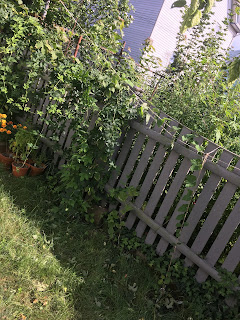For a homebrewer growing hops in the backyard, hop harvest is a lot more work. The tendricles that allow hops to climb can really irritate the skin. Gloves and long sleeves are a must. On a still-warm late August day it can be quite hot. I drank three bottles of water while picking cones off of my first bine.
The cones on the bine will ripen at different times. One advantage a home-grower has is the ability to pick the cones as they ripen over a period of time. For a large commercial grower this is entirely impractical.
Last year I planted five rhizomes: Willamette, Northern Brewer, Chinook, Cascade, Centennial. I clipped the Cascade with my edger and it never grew back. The other four plants did grow nicely their first year.
First-year hops typically don't yield many cones if they even do at all. The Northern Brewer actually yielded quite a bit. Enough for me to brew a batch, a California Common I named Uncommon First Harvest. Using the pick as you go method, I was able to dry the hops on a screen. After tasting the beer I brewed the lack of hop flavor made it pretty clear that I picked the hops too soon. There was almost no hop flavor, but the Muntons Crystal malt flavor really came through and I thoroughly enjoyed the beer.
For this year I planted three new hop plants, not rhizomes: Cluster, Brewers Gold, and Canadian Red Vine. The Cluster and Brewers Gold were purchased with the idea of using them in historic recipes. Canadian Red Vine on the other hand I had never heard of. It's supposed cherry flavor sounded interested. That it has French-Canadian origin (like me!), made me think it would grow well in New England.
Here is a rundown of how my plants did this year
Northern Brewer: Again this was my most vigorous grower. The cones were ready for harvest the fourth week of August. I knew the cones were ready when I saw more yellow lupulin than when I harvested last year, and some of the leaves were just starting to yellow and brown ever so slightly. The clincher was when I rubbed a cone in my hands I could see and feel the hop oil in my hands. With the huge volume of cones, I elected to harvest them all at once. I could barely fit the yield in a five-gallon bucket.
 |
| Look at all of those cones! |
 |
| I could barely fit the plant in the frame. Lots of shoots with good cones too, |
 |
| The Centennial in the shade. It isn't high enough to clear the neighbor's deck. |
 |
| The Willamette produced a few cones in year two and does look pretty hanging off of my porch, |
Cluster and Brewers Gold: Planting dormant plants as opposed to rhyzomes is that plants are supposed to grow more vigorously their first year. That was not the case with these two. I planted these along my fence on either side of the Northern Brewer where I thought they would get the most sunlight. Instead the Norther Brewer shaded out both of these. The Cluster eventually slowly started to grow. With the Northern Brewer cut down it should have six to eight weeks of warm weather and sunlight to help the root system for next year.
 |
| The Cluster is the thin plant to the right. |
The Brewers Gold never took off in it's original location. I replanted it along my porch next to the stairs. While that location is blocked from the morning sun, it does get plenty of sun from mid-afternoon onward. It did slowly start to take off a little bit in its new location.
 |
| Believe it or not this is improvement. |
Canadian Red Vine: By the time my new plants arrived I had completely forgotten that I ordered this one. I planted it along the porch just to see how it would do. I was concerned about the lack of morning sunlight which proved not to be an issue at all. The plant reached the top of the porch, then found a cable line along the side of the house, and worked it's way up that. The plant has produced plenty of cones that probably won't be ready to harvest for another few weeks.
 |
| The roofline on the porch is probably 15'-20' high. |
Expecting a larger yield, I purchased some new toys to properly store my homegrown hops. I bought a food dehydrator to speed up the drying process. There are all kinds of DIY hop drying projects that involve box fans, building wood frames, and stapling screens to them. The dehydrator I purchased was $80, but give me a turnkey solution and I will take it every time. I can also use the machine to make beef jerky! To store my dried hops I bought a vacuum sealer.
 |
| I end up with 6oz of dried hops per batch. |
The dehydrator is working great! With the temperature set at 95F the hops dry in nine hours. With the huge yield of Northern Brewer I will probably have to run five to six batches to dry them all. Wet hops, hops that are picked fresh off the bine, will start to get moldy after three days. I should just be able to get them all dry by then.
I weighed out my dried hops into two ounce bags which were then vacuum-sealed. The bags for the vacuum sealer come in a roll and it took some trial and error to figure out how large of a bag to cut. As I work through these hops the next challenge might be to find enough fridge
Like The Would-be Brewmaster on Facebook
No comments:
Post a Comment